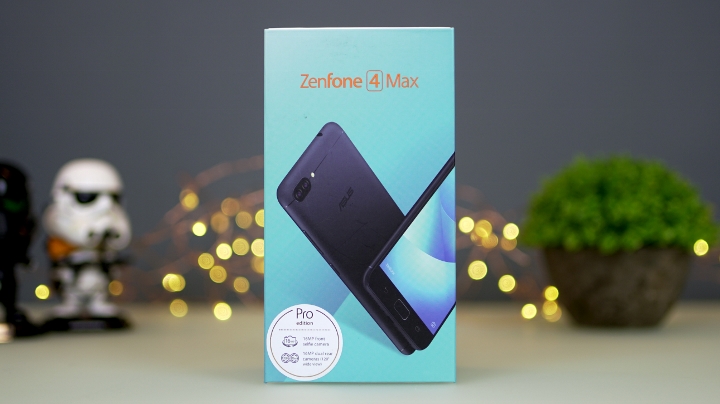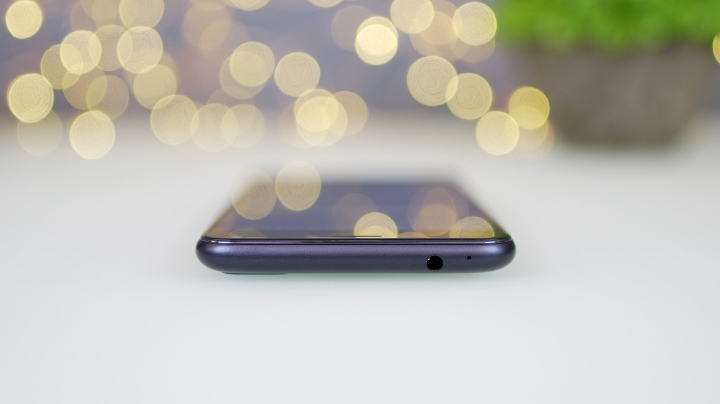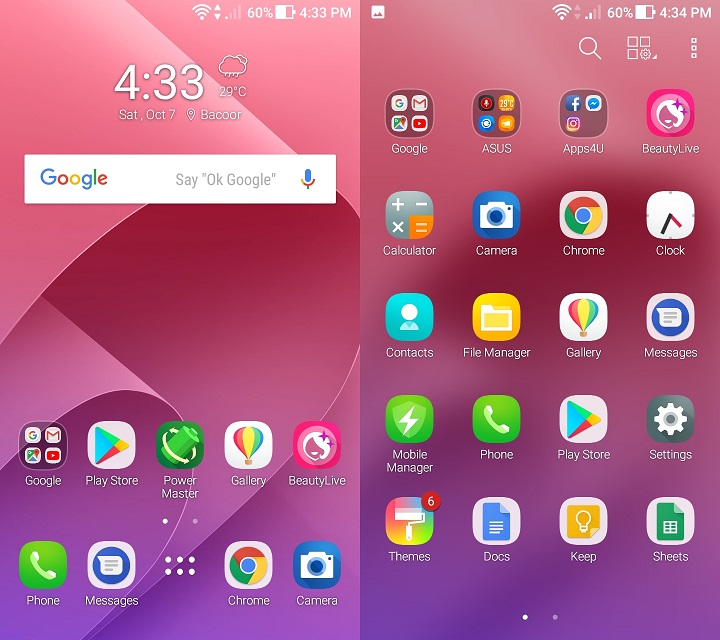In August, ASUS revealed their ZenFone 4 Series of smartphones. Two of them is the ZenFone 4 Max and ZenFone 4 Max Pro. Both devices are positioned to be great daily drivers thanks to their dual-rear cameras, capable processors, and large batteries. The only difference is that the Pro model sports a higher resolution cameras. Is it worth jumping to this one instead of the standard model? Let’s find out.

Author’s Note: Since the ZenFone 4 Max Pro is pretty much identical to the ZenFone 4 Max, we will carry some parts of our ZenFone 4 Max Review to this review.
Table of Contents
The Max has grown quite a lot over the past 2 years which is noticeable in its design. The bulky body has now been replaced by a sleeker and more premium look. If you ask us, the Zenfone 4 Max Pro’s design is closer to the Zenfone 3 Zoom’s but chunkier.

The front houses the 5.5-inch display which is the same screen size used for the original Zenfone Max and Zenfone 3 Max. Placed above are the earpiece, 8MP camera, and LED flash.

Down below are the unlit capacitive buttons for Back and Recent Apps. Placed right in the middle is the fixed Home button that doubles as the fingerprint scanner.

Found on the left is the card tray in which we’re glad to report that it can accommodate two nano-sized SIM cards and a microSD card. While on the right are the metallic power/lock and volume buttons.

Placed up top are the audio port and secondary microphone. While down below are the two sets of holes for the loudspeaker and main microphone. Situated in the middle is a micro-USB port which could be a disadvantage especially to those who prefer the USB Type-C standard.

Flip on its back and you will see the dual rear camera setup, LED flash, and a pair of glossy strips which segments the top and bottom parts of the device.

On the hand, the Zenfone 4 Max Pro feels solid and reasonably hefty at 181 g. Despite the large 5,000mAh battery, it’s now thinner than the original Zenfone Max at 8.9 mm. It’s just 0.6 mm thicker than the Zenfone 3 Max with a smaller 4,100mAh battery.

The metal unibody is cool to the touch while the curved sides make it easy to grip and use even with one hand. The 2.5D glass also makes the device feel almost seamless when you run your fingers around it.
The Zenfone 3 Max came out with a 5.5-inch display with Full HD resolution. In the case of the Zenfone 4 Max Pro, we were disappointed that the model we have on hand only packs an HD resolution or equal to 267ppi. It’s not that bad though but if you’re used to at least Full HD, this can feel a bit of a downgrade, especially if you consider its “Pro” status.

Despite the lower resolution, the quality will suffice for daily phone activities like watching videos, viewing photos, or gaming. Viewing angles are okay and bright enough to be used outdoors, however, we noticed that the color is too cool to our liking. We looked at Settings for the ASUS Splendid app but it’s not available. As it turns out, the feature doesn’t support the Zenfone 4 Max Pro.
When it comes to audio, the down-firing speakers are audible and crisp which is good enough for hands-free voice calls and casual listening but since it’s lacking in bass, you might want to use earphones or an external speaker for a better audio experience.
Running the software department is Android 7.1.1 Nougat with ZenUI. The design of the UI still remains the same which is good if you like it, but if you prefer something else, you can easily remedy that by downloading your favorite launcher.

Perhaps, the biggest improvement here is the removal of bloatware or apps that users don’t necessarily need. There are no pre-installed games and third-party apps that are normally found in older Zenfone devices. Even the ASUS apps get a massive trimming, although it would have been nice if they retained the ASUS Splendid and AudioWizard features we mentioned earlier.

There’s still the usual Google apps including Docs, Sheets and Slides, and basic social media apps like Facebook, Messenger, and Instagram which we don’t mind. As for storage, it comes with 32GB of storage with 23.31GB left for the user which is not bad. You can further expand it via microSD with its dedicated slot, or USB OTG.
This is the part that separates the ZenFone 4 Max Pro from the ZenFone 4 Max. It sports a 16MP + 5MP (wide-angle) rear camera and 16MP front, which is a bump in resolution compared to the 13MP + 5MP (wide-angle) rear and 8MP front on the ZenFone 4 Max.

Quality-wise, we don’t see any difference from the ZenFone 4 Max. It’s good in bright conditions but sluggish indoors. The front camera, on the other hand, is sharper now with more accurate colors. As for in-camera features, it’s limited to Beauty, Super Resolution, Panorama, Auto, Pro, GIF Animation, and Time Lapse. The Beauty Live app from the Zenfone Live makes its way here as well.
When it comes to video recording, the Zenfone 4 Max can shoot at Full HD resolution at 30fps with quality similar to the photos. We noticed that it doesn’t support lens switching while recording. So if you’re shooting with the main camera and want to switch to the wide-angle, you’ll have to stop recording, switch lens then hit record again.
Powering the ZenFone 4 Max Pro is a Qualcomm Snapdragon 435 octa-core CPU clocked at 1.4Ghz, Adreno 505 GPU, and 3GB RAM. The only difference with the ZenFone 4 Max is the processor and it’s not even a big improvement. The SD435 has all the features of the SD430 with the addition of Snapdragon X9 LTE modem capable of LTE Cat7 downlink and LTE Cat13 uplink.

We’re still getting the same level of performance as the ZenFone 4 Max, meaning it’s responsive in all the tasks we throw at it including gaming. Benchmark scores are not much different.
Connectivity features are the same as the ZenFone 4 Max – WiFi b/g/n, Bluetooth 4.2, micro-USB OTG, GPS, and a fingerprint scanner that can support 5 fingers with 360-degree recognition. The difference is the Snapdragon X9 LTE modem capable of LTE Cat7 downlink and LTE Cat13 uplink. In comparison, the SD430 has a Snapdragon X6 LTE with LTE Cat4 downlink.

So far everything works as advertised – call quality is good, connects to mobile data quickly as long as the area has good LTE coverage. GPS is also good as it can lock to our location with ease when using apps like Google Maps and Waze.
Battery capacity is the same at 5,000mAh with reverse charging and PowerMaster feature. As expected, battery life is long and it can last us 2 days without having to tone-down our usage.

In our video loop test, we were surprised to get a better result at 18 hours and 39 minutes of playback, compared to the 16 hours and 30 minutes on the ZenFone 4 Max. We can probably attribute this to the OTA updates that ASUS pushes to the device. As for charging, it takes less than 3 hours from 0% to full as it doesn’t have Fast Charging.
Note: PC Mark result is not available as the app crashes halfway through the test.
The ZenFone 4 Max Pro is basically a slightly better-equipped twin of the ZenFone 4 Max. The “Pro” moniker is just there to emphasize its inclination to mobile photography, hence, the improved camera spec. There’s the Snapdragon 435 but all you’re getting is a faster modem. We’re disappointed that it doesn’t offer anything other than that. ASUS could have justified its existence by equipping it with 64GB of storage to make room for more photos and videos.

Don’t get us wrong, the ZenFone 4 Max Pro is not a bad device. But considering its similarities to the ZenFone 4 Max, releasing the Pro just feels unnecessary. ASUS should have just scrapped the ZenFone 4 Max and just offered the ZenFone 4 Max Pro for the same price. That would add value to the whole thing.
The ASUS ZenFone 4 Max Pro is available at Widget City for Php13,995USD 238INR 20,217EUR 227CNY 1,737. See listing here.
ASUS ZenFone 4 Max Pro (ZC554KL) specs:
5.5-inch HD IPS display, 267ppi
2.5D glass
1.4GHz Qualcomm Snapdragon 435 octa-core CPU
Adreno 505 GPU
3GB RAM
32GB ROM
up to 256GB via microSD card (dedicated slot)
16MP main rear camera w/ LED flash
5MP secondary rear camera (wide-angle)
16MP front camera w/ LED flash
Dual-SIM (nano)
4G LTE
WiFi 802.11 b/g/n
Bluetooth 4.1
micro-USB 2.0
USB OTG
GPS, A-GPS, Glonass, BDS
Fingerprint scanner
Android 7.1.1 Nougat w/ ZenUI
5,000mAh non-removable battery
154 x 76.9 x 8.9 mm
181 g
Deepsea Black, Sunlight Gold, Rose Pink
What we liked:
* Premium design
* Large battery w/ reverse charging
* Dual rear cameras
* Better front camera
* Triple card slot
What we didn’t:
* HD display
* Can’t switch between lenses while recording
* Doesn’t offer much difference from the ZenFone 4 Max

YugaTech.com is the largest and longest-running technology site in the Philippines. Originally established in October 2002, the site was transformed into a full-fledged technology platform in 2005.
How to transfer, withdraw money from PayPal to GCash
Prices of Starlink satellite in the Philippines
Install Google GBox to Huawei smartphones
Pag-IBIG MP2 online application
How to check PhilHealth contributions online
How to find your SIM card serial number
Globe, PLDT, Converge, Sky: Unli fiber internet plans compared
10 biggest games in the Google Play Store
LTO periodic medical exam for 10-year licenses
Netflix codes to unlock hidden TV shows, movies
Apple, Asus, Cherry Mobile, Huawei, LG, Nokia, Oppo, Samsung, Sony, Vivo, Xiaomi, Lenovo, Infinix Mobile, Pocophone, Honor, iPhone, OnePlus, Tecno, Realme, HTC, Gionee, Kata, IQ00, Redmi, Razer, CloudFone, Motorola, Panasonic, TCL, Wiko
Best Android smartphones between PHP 20,000 - 25,000
Smartphones under PHP 10,000 in the Philippines
Smartphones under PHP 12K Philippines
Best smartphones for kids under PHP 7,000
Smartphones under PHP 15,000 in the Philippines
Best Android smartphones between PHP 15,000 - 20,000
Smartphones under PHP 20,000 in the Philippines
Most affordable 5G phones in the Philippines under PHP 20K
5G smartphones in the Philippines under PHP 16K
Smartphone pricelist Philippines 2024
Smartphone pricelist Philippines 2023
Smartphone pricelist Philippines 2022
Smartphone pricelist Philippines 2021
Smartphone pricelist Philippines 2020
M says:
The 2-hr bump in battery life may most probably be attributed to the decrease in resolution. And that’s a welcome trade.
Crimson says:
The 2 hour increase was compared to the ZenFone 4 Max, which also has an HD display, so I think that’s not it. Most likely the updates, like what the article said.
ovriel says:
help naman po, ano yung nababasa ko na 4gb /64gb version ng zenfone 4 max? meron ba sa pinas???
Ivy abodo says:
Hello ask lng po ako nakabili po ako asus celpon 4 max bkit po bigla cyang namamatay